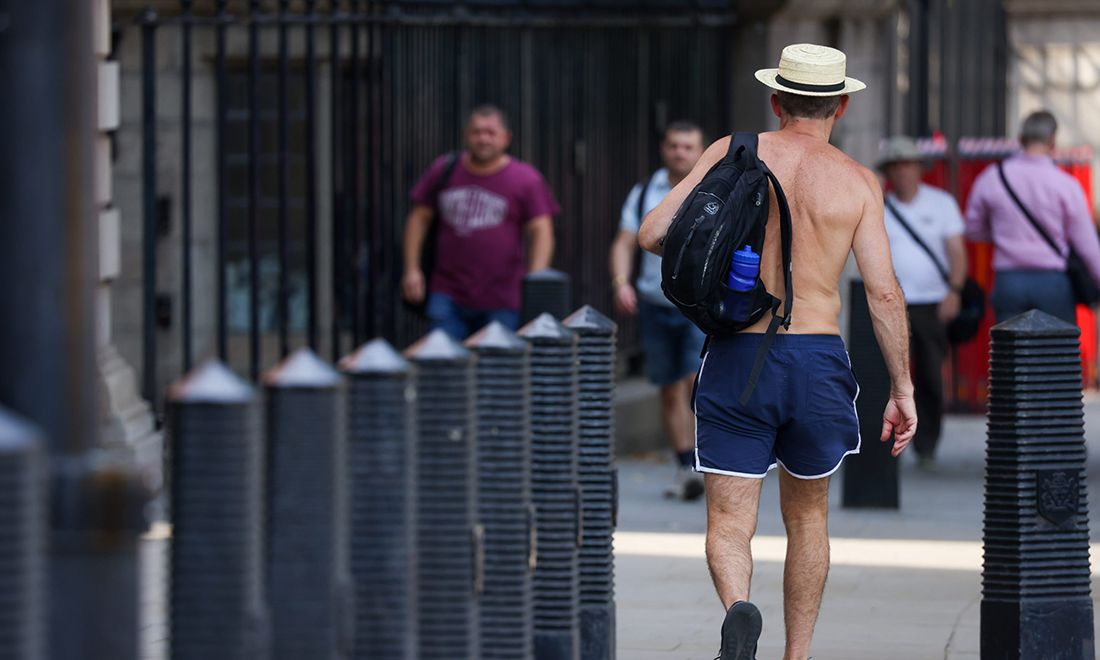热浪席卷全球,不同群体看法不同

英国正在经历一场史诗级热浪,创造了英国历史上最热的(暂时是)一天,气温飙至104.4华氏度(超40.2摄氏度)。英国政府已经宣布全国因恶劣天气进入紧急状态,英国气象局发布了史上第一个“极端高温红色预警”,提醒公众高温可能导致死亡。
而英国只是最近一个被这股席卷欧洲的热浪笼罩的国家。高温在西班牙点燃了野火,给葡萄牙带来了持续干旱,热化了英国机场的跑道,进一步加剧了伦敦卢顿机场的航班延误。
尽管高温天气危害严重,但公共卫生官员发现,高温预警并不像其他自然灾害预警那样能引起公众的共鸣。
“应对高温天气的问题在于,不是每个人都认为天气炎热不好,”南加州大学公共政策和行为科学教授布鲁因说道。
你怎么看待极端高温天气的风险,取决于你是哪里人
布莱因说,在英国这样长年湿冷的国家,人们可能会认为暴雨、暴雪和洪水等极端潮湿寒冷的天气是“差”天气,但更可能会对炎热的天气表示欢迎,因为终于可以从一成不变的阴沉中喘口气。
相反,炎热地区的人更容易认识到高温的潜在风险。布莱因说:“如果你中过暑,或者曾因为高温天气有过不好的经历,愿意做好自我防护的可能性就越高。”
极端高温对公众健康和经济都会造成不利影响。根据美国疾病控制与预防中心的数据,美国每年死于高温的人数比其他任何极端天气都要多,包括飓风和洪水在内。
与此同时,智库大西洋理事会(Atlantic Council)的研究人员估计,2021年热浪给美国经济造成了1000亿美元的损失,因为高温导致停电停工,超过了同年飓风造成的650亿美元的经济损失。
但高温给经济带来的影响看起来是懒洋洋的,不像时速100英里的大风那样能制造冲击画面,不会掀翻屋顶或刮断电线,因此没有经历过高温的人很难将其视为一种威胁。
2015年,耶鲁大学的研究人员发现,生活在美国南部各州的人可能比生活在气候温和的北部各州的人更重视高温的风险。但该研究还表明,因为当地的常住人口不同,即使在天气炎热的州,对高温风险的感知也可能因县而异。
边缘群体更有可能认为高温是一种健康威胁
研究人员发现,与穷人和有色人种相比,富裕的美国白人不太可能把高温视为健康风险。造成这种差异的原因是,美国的高温对贫穷和非白人群体造成了不成比例的伤害,因为这些人无法乘凉、没有空调或其他降温措施的可能性更高。
此外,弱势群体暴露在热浪中工作的可能性更高,这意味着他们因为高温天气扰动经济生活而遭受经济损失的可能性也更高。大西洋理事会的数据显示,美国黑人和西班牙裔居民“比白人多(损失)18%的生产力……因为他们生活在高温地区的比例更高。”
公卫专家称应改变极端高温预警体系
最不习惯应对极端高温的人最不可能认识到热浪的威胁,这给公共卫生官员们提出了一个难题——如何说服公众做好自我防护,免受中暑之苦。
“那些喜欢温暖天气的人在高温天气时往往不太可能采取专家建议的预防措施,比如在一天中最热的时间远离太阳,避免在太阳下运动,大量饮水等等,”布莱因说。
布莱因建议说:“政府的沟通重点应该放在人们如何在享受阳光的同时避免中暑或遭受其他不愉快经历。”她说,对于从未受过高温之苦的人来说,有关高温危害的警告“听起来可能不太真实”。
同样,“热浪”在各地的含义也不尽相同。因为热浪的定义具有区域性,如果当地一段时间的温度长时间高于正常水平,即称为热浪,所以英国的热浪通常不会像德克萨斯州的热浪那么热。
但是,由于气候变化导致英国平均气温上升,气象部门在今年1月上调了热浪的门槛。伦敦“热浪”的最低值是82华氏度,但当地本周气温预计将达到104华氏度。(财富中文网)
译者:Agatha
英国正在经历一场史诗级热浪,创造了英国历史上最热的(暂时是)一天,气温飙至104.4华氏度(超40.2摄氏度)。英国政府已经宣布全国因恶劣天气进入紧急状态,英国气象局发布了史上第一个“极端高温红色预警”,提醒公众高温可能导致死亡。
而英国只是最近一个被这股席卷欧洲的热浪笼罩的国家。高温在西班牙点燃了野火,给葡萄牙带来了持续干旱,热化了英国机场的跑道,进一步加剧了伦敦卢顿机场的航班延误。
尽管高温天气危害严重,但公共卫生官员发现,高温预警并不像其他自然灾害预警那样能引起公众的共鸣。
“应对高温天气的问题在于,不是每个人都认为天气炎热不好,”南加州大学公共政策和行为科学教授布鲁因说道。
你怎么看待极端高温天气的风险,取决于你是哪里人
布莱因说,在英国这样长年湿冷的国家,人们可能会认为暴雨、暴雪和洪水等极端潮湿寒冷的天气是“差”天气,但更可能会对炎热的天气表示欢迎,因为终于可以从一成不变的阴沉中喘口气。
相反,炎热地区的人更容易认识到高温的潜在风险。布莱因说:“如果你中过暑,或者曾因为高温天气有过不好的经历,愿意做好自我防护的可能性就越高。”
极端高温对公众健康和经济都会造成不利影响。根据美国疾病控制与预防中心的数据,美国每年死于高温的人数比其他任何极端天气都要多,包括飓风和洪水在内。
与此同时,智库大西洋理事会(Atlantic Council)的研究人员估计,2021年热浪给美国经济造成了1000亿美元的损失,因为高温导致停电停工,超过了同年飓风造成的650亿美元的经济损失。
但高温给经济带来的影响看起来是懒洋洋的,不像时速100英里的大风那样能制造冲击画面,不会掀翻屋顶或刮断电线,因此没有经历过高温的人很难将其视为一种威胁。
2015年,耶鲁大学的研究人员发现,生活在美国南部各州的人可能比生活在气候温和的北部各州的人更重视高温的风险。但该研究还表明,因为当地的常住人口不同,即使在天气炎热的州,对高温风险的感知也可能因县而异。
边缘群体更有可能认为高温是一种健康威胁
研究人员发现,与穷人和有色人种相比,富裕的美国白人不太可能把高温视为健康风险。造成这种差异的原因是,美国的高温对贫穷和非白人群体造成了不成比例的伤害,因为这些人无法乘凉、没有空调或其他降温措施的可能性更高。
此外,弱势群体暴露在热浪中工作的可能性更高,这意味着他们因为高温天气扰动经济生活而遭受经济损失的可能性也更高。大西洋理事会的数据显示,美国黑人和西班牙裔居民“比白人多(损失)18%的生产力……因为他们生活在高温地区的比例更高。”
公卫专家称应改变极端高温预警体系
最不习惯应对极端高温的人最不可能认识到热浪的威胁,这给公共卫生官员们提出了一个难题——如何说服公众做好自我防护,免受中暑之苦。
“那些喜欢温暖天气的人在高温天气时往往不太可能采取专家建议的预防措施,比如在一天中最热的时间远离太阳,避免在太阳下运动,大量饮水等等,”布莱因说。
布莱因建议说:“政府的沟通重点应该放在人们如何在享受阳光的同时避免中暑或遭受其他不愉快经历。”她说,对于从未受过高温之苦的人来说,有关高温危害的警告“听起来可能不太真实”。
同样,“热浪”在各地的含义也不尽相同。因为热浪的定义具有区域性,如果当地一段时间的温度长时间高于正常水平,即称为热浪,所以英国的热浪通常不会像德克萨斯州的热浪那么热。
但是,由于气候变化导致英国平均气温上升,气象部门在今年1月上调了热浪的门槛。伦敦“热浪”的最低值是82华氏度,但当地本周气温预计将达到104华氏度。(财富中文网)
译者:Agatha
The U.K. is enduring a blistering heat wave that provisionally delivered the country’s hottest day on record, as temperatures boiled to 104.4°F. The British government has declared the severe weather a national emergency, and the U.K. meteorological office issued its first ever “red extreme heat warning,” cautioning that the high temperatures could lead to death.
The U.K. is just the latest country enveloped by a sweltering heat wave that has swept over Europe, sparking wildfires in Spain, prolonging drought in Portugal, and warping runways in England, causing further flight delays at London’s Luton Airport.
Despite the dangerously high temperatures, public health officials find that their warnings about heat don’t resonate with the public the way alarms about other natural disasters do.
“With heat waves, the problem is that not everyone thinks of hot weather as bad,” says Wändi Bruine de Bruin, a professor of public policy and behavioral science at the University of Southern California.
Your perception of extreme heat risk depends on where you live
Bruine de Bruin says people who live in countries that are normally wet and cool, like the U.K., are likely to view excessively inclement weather—heavy rain, snow, and floods—as “bad” weather, but more likely to welcome hot weather as a respite from the common dreariness.
Conversely, people who live in persistently hot areas are more likely to recognize the potential risks of higher temperatures. Bruine de Bruin says, “If you have past experience with heatstroke or other unpleasant consequences of heat waves, you are probably more likely to protect yourself.”
Extreme heat is bad, both for public health and the economy. According to the U.S. Centers for Disease Control and Prevention (CDC), more people die each year owing to heat than any other extreme weather event in the U.S., including hurricanes and floods.
Meanwhile, researchers at think tank the Atlantic Council estimate that heat waves stripped $100 billion off the U.S. economy in 2021, as scorching temperatures caused power outages and work stoppages—more than the $65 billion in economic loss caused by hurricanes the same year.
But the sluggish slowdown associated with intense heat doesn’t typically provide the same drama as 100 mph winds that rip roofs off houses and tear down power lines, which can make it difficult for people with little experience with intense heat to visualize it as a threat.
In 2015, researchers at Yale found that people living in the southern states of the U.S. were likely to rank heat as a greater personal risk than their compatriots in temperate northern states. But the research also showed that, even within hot states, the perception of heat risk could vary county to county, based on the demographics of those living there.
Marginalized groups are more likely to consider heat a health risk
Richer, white Americans were less likely than poorer people and people of color to see heat as a health risk, the researchers found. That disparity is because heat in the U.S. disproportionately harms poorer and non-white neighborhoods, where the public has less access to shade, AC, and other cooling measures.
Disadvantaged populations are also more likely to work jobs that place them at risk of heat exposure, which means they also disproportionately suffer the economic fallout of heat disruption. According to the Atlantic Council, Black and Hispanic residents in the U.S. lose “18% more in productivity than their White counterparts…because they live in higher percentages in heat-stressed locations.”
Public health experts should change their extreme heat messaging
The fact that people who are least accustomed to dealing with extreme heat are the least likely to recognize heat waves as a threat poses a conundrum for public health officials, tasked with persuading the public to protect themselves against heatstroke.
“Those who like the idea of warmer weather tend to be less likely to take recommended precautions when it gets hot, such as staying out of the sun during the hottest time of the day, avoiding exercise in the sun, or drinking lots of water,” Bruine de Bruin says.
“It might be better for messages to focus on how people can enjoy the sun, without putting themselves at risk for heatstroke or other unpleasant experiences,” Bruine de Bruin suggests. Warnings about how heat is dangerous “may not ring true” to people who have never suffered from it, she says.
It’s also true that the meaning of “heat wave” changes by location. Because heat waves are defined regionally, recorded as prolonged periods of temperature above the norm for a particular location at a particular time of year, a heat wave in the U.K. is usually not going to be as hot as a heat wave in Texas.
However, because climate change is increasing average temperatures in the U.K., the meteorological office raised its thresholds for declaring a heat wave in January this year. In London, the “heat wave” threshold is set at 82°F, yet temperatures in the city are expected to hit 104°F this week.













